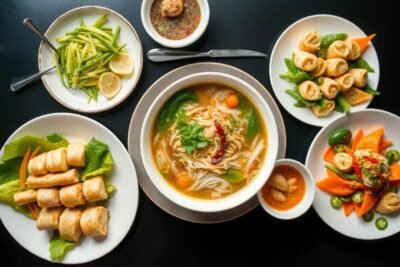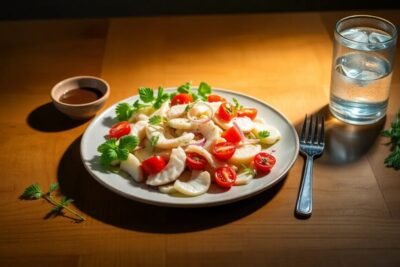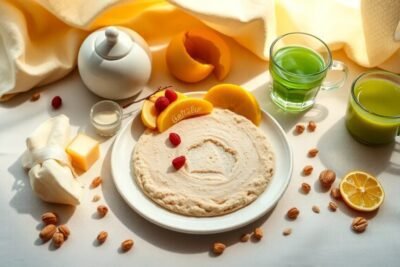
Delicious Diabetes-Friendly Shrimp Recipes You Must Try
- Introduction to Diabetes and Nutrition
- Why Choose Shrimp for Your Diabetes-Friendly Diet?
- Culinary Benefits of Cooking with Shrimp
- Simple Shrimp Recipes to Get You Started
- Shrimp Stir-Fry: A Quick and Versatile Meal
- Baked Shrimp with Herbal Marinade: A Flavorful Delight
- Shrimp Tacos with a Twist: A Guilt-Free Indulgence
- Pairing Shrimp Dishes with Healthy Sides
- Final Tips for Cooking and Enjoying Shrimp
Introduction to Diabetes and Nutrition
Nutrition serves a pivotal role in managing diabetes, influencing blood sugar levels and overall health. Individuals with diabetes must pay close attention to their dietary choices to maintain optimal blood glucose control. A well-structured meal plan not only helps in regulating blood sugar but also supports overall well-being. This involves selecting ingredients that are low in carbohydrates and rich in nutrients.
One significant aspect of a diabetes-friendly diet is the inclusion of lean proteins, which contribute to feeling full and satisfied without causing spikes in blood sugar levels. One excellent source of lean protein is shrimp, which is low in calories and carbohydrates while being rich in essential nutrients. Shrimp can be prepared in various ways, making it a versatile ingredient that fits seamlessly into numerous diabetes-friendly shrimp recipes.
When planning meals, it is crucial to focus on balancing macronutrients. Carbohydrates should be carefully managed, while the integration of proteins and healthy fats can provide sustained energy. A diet rich in whole grains, fruits, vegetables, and lean proteins like shrimp can help prevent the fluctuations associated with diabetes. Incorporating diabetes-friendly shrimp recipes into one’s meal plan can contribute to better health outcomes and create a more enjoyable dining experience.
Moreover, the health benefits of shrimp extend beyond protein content. Shrimp are also a source of omega-3 fatty acids, which are known to support heart health, a significant concern for those managing diabetes. By focusing on such nutritious ingredients and crafting diabetes-friendly meals, individuals can enjoy flavorful dishes while effectively managing their health. Therefore, exploring diabetes-friendly shrimp recipes can be an essential step toward achieving a balanced and health-conscious diet.
Why Choose Shrimp for Your Diabetes-Friendly Diet?
Shrimp is an exceptional food choice for individuals managing diabetes, boasting an impressive nutritional profile that aligns well with dietary needs. One of the standout features of shrimp is its low calorie content. Averaging about 84 calories per three-ounce serving, shrimp provides a filling option without contributing to excessive calorie intake. This aspect is particularly advantageous for those looking to maintain a healthy weight, which is crucial for diabetes management.
Moreover, shrimp is an excellent source of high-quality protein. Each serving provides roughly 18 grams of protein, essential for muscle maintenance, repair, and overall health. Protein consumption can assist in feelings of satiety, which is particularly beneficial for blood sugar control. When managing diabetes, ensuring a balanced intake of macronutrients is critical, and protein plays a significant role in this balance. It helps to stabilize blood sugar levels, preventing spikes that can occur with high carbohydrate meals.
Additionally, shrimp is rich in essential vitamins and minerals, including vitamin B12, iodine, and selenium. Vitamin B12 supports nerve function and energy production, which can be beneficial given that nerve health can be a concern for individuals with diabetes. Iodine plays a role in metabolism regulation, enhancing energy levels, while selenium is an antioxidant that helps combat oxidative stress. Together, these nutrients contribute to overall health, making shrimp a more than suitable component of a diabetes-friendly diet.
In summary, incorporating diabetes-friendly shrimp recipes into your meal planning can offer a plethora of health benefits. The combination of low calories, high protein content, and rich nutrient density supports not only satiety but also the maintenance of stable blood sugar levels, making shrimp an ideal choice for those living with diabetes.
Culinary Benefits of Cooking with Shrimp
Shrimp is a highly versatile ingredient that can enhance a myriad of dishes, particularly for those seeking diabetes-friendly options. Its delicate flavor and firm texture allow for numerous cooking methods such as grilling, sautéing, boiling, and baking. Each method not only alters the shrimp's texture but also prepares it for diverse culinary applications. For instance, grilled shrimp can be served as part of a salad or on skewers, while sautéed shrimp can easily blend into a stir-fry or pasta dish.
One of the many advantages of using shrimp in diabetes-friendly shrimp recipes is its remarkable adaptability to various cuisines. From spicy shrimp tacos in Mexican fare to creamy garlic shrimp in Italian dishes, this seafood can seamlessly fit into global menus. In Asian cooking, shrimp is often paired with fresh vegetables and herbs, which not only adds flavor but also increases the nutritional profile of the dish. Herbs like cilantro, basil, and ginger complement shrimp well, providing not just taste but also health benefits that are essential for blood sugar control.
Another crucial aspect of cooking with shrimp is the ease of infusing different flavors. Marinades featuring citrus, garlic, or spices can transform shrimp into a flavorful centerpiece that adheres to dietary needs. The ability of shrimp to absorb surrounding flavors makes it an excellent candidate for experimenting with diabetes-friendly shrimp recipes that utilize low-sodium soy sauce, fresh lime juice, or zesty spices.
Considering its health benefits, including low calories and high protein content, shrimp is an excellent choice for those with diabetes. Its quick cooking time also makes shrimp an ideal solution for busy weeknight meals. Incorporating this seafood into your culinary repertoire can yield a spectrum of dishes that are both delicious and considerate of diabetes management.
Simple Shrimp Recipes to Get You Started
If you are looking for diabetes-friendly shrimp recipes that are both easy to prepare and satisfyingly delicious, you are in the right place. Shrimp is a lean source of protein, low in carbohydrates, and packed with essential nutrients, making it an excellent choice for those managing their blood sugar levels. Here are some simple shrimp recipes designed to help you enjoy this seafood staple without the worry of spiking your glucose levels.
One easy dish to try is a garlic shrimp stir-fry. Begin by sautéing minced garlic and ginger in a small amount of olive oil. Then, add fresh or frozen shrimp, cooking for just a few minutes until they turn pink. Incorporate colorful vegetables like bell peppers, broccoli, and snap peas to boost nutritional value. Season with low-sodium soy sauce and serve over a small portion of brown rice or quinoa for a complete meal. This wholesome recipe embodies the essence of diabetes-friendly shrimp recipes.
Another quick option is the shrimp and vegetable skewers. Marinate peeled shrimp in a mixture of olive oil, lemon juice, and herbs (such as thyme and rosemary), then thread them onto skewers alternately with cherry tomatoes, zucchini, and bell peppers. Grill or bake until the shrimp are opaque and the vegetables are tender. This dish not only offers vibrant flavors but also maintains a balanced carbohydrate count, emphasizing the importance of vegetables in diabetes management.
Lastly, consider preparing a shrimp salad featuring mixed greens, avocado, cucumber, and diced tomatoes. Toss in cooked shrimp, and dress with a light vinaigrette. This refreshing meal is low in calories and high in fiber, allowing for healthy digestion. All of these recipes align perfectly with the principles of diabetes-friendly eating, making them ideal options that are both simple and nutritious.
Shrimp Stir-Fry: A Quick and Versatile Meal
Shrimp stir-fry is an excellent, diabetes-friendly dish that can be prepared swiftly, making it ideal for busy individuals seeking nutritious meals. This recipe combines succulent shrimp with vibrant vegetables, ensuring a delightful array of flavors and textures. Additionally, it allows for customization according to personal preferences and the availability of ingredients, thereby making it one of the most versatile meals you can whip up in no time.
To start, gather the following ingredients: one pound of shrimp, peeled and deveined; a mix of your favorite vegetables such as bell peppers, snap peas, and broccoli; two tablespoons of low-sodium soy sauce; a tablespoon of olive oil; and minced garlic and ginger for added flavor. Begin by heating olive oil in a large skillet over medium-high heat. Once hot, add the minced garlic and ginger, sautéing them for about 30 seconds until fragrant.
Next, incorporate the shrimp into the skillet. Cook for approximately 2-3 minutes until they turn pink and opaque. It's essential to avoid overcooking the shrimp to maintain their tenderness. Afterward, add the vegetables to the pan. Stir-fry the mixture for an additional 3-5 minutes, allowing the vegetables to become slightly tender while remaining crisp. The vibrant colors from the vegetables not only enhance the visual appeal of the dish but also contribute vital nutrients essential for managing diabetes.
Once everything is cooked, pour the low-sodium soy sauce over the stir-fry mixture and toss gently to ensure an even distribution of flavor. Serve immediately, either on its own or over a base of brown rice or quinoa for added health benefits. This shrimp stir-fry is a delicious option that highlights how diabetes-friendly shrimp recipes can be quick, satisfying, and easy to prepare, making healthy eating a seamless part of your lifestyle.
Baked Shrimp with Herbal Marinade: A Flavorful Delight
Baked shrimp with an herbal marinade is an excellent choice for those managing diabetes, as this recipe not only aligns with dietary needs but also promises a burst of flavors. Shrimp is inherently low in calories and saturated fats, making it a suitable protein source. When baked, shrimp retains its natural moisture and tenderness, ensuring a delightful bite with every forkful. This method requires minimal oil, which contributes to a healthier meal overall.
The key to elevating baked shrimp lies in the marinade. Creating a flavorful herbal mixture is simple yet rewarding. Begin with a base of fresh herbs such as parsley, basil, and cilantro, which not only infuse the shrimp with vibrant flavors but also provide essential nutrients and antioxidants. Adding garlic enhances both the taste and health benefits, as it is known to improve cardiovascular health. A splash of lemon juice offers a zesty kick that brightens the dish while promoting digestion, an essential factor for individuals with diabetes.
In preparing the marinade, carefully controlling the use of salt is paramount. Opt for low-sodium alternatives or incorporate spices to enrich the flavor without adding unwanted sodium. This approach keeps the dish diabetes-friendly while ensuring that the flavors are anything but compromised. Adjusting the balance of herbs and spices allows for a personalized touch, accommodating individual taste preferences.
Once the shrimp is marinated for approximately 30 minutes, it is then baked in the oven until perfectly cooked. The result is a succulent and fragrant dish that stands out, making it a perfect addition to any diabetes-friendly menu. Serve the baked shrimp alongside a light salad or steamed vegetables for a wholesome meal that will leave you feeling satisfied and nourished.
Shrimp Tacos with a Twist: A Guilt-Free Indulgence
When it comes to creating diabetes-friendly shrimp recipes, shrimp tacos are a delicious yet healthy option. These tacos can be made fresh and flavorful, incorporating nutritious ingredients that not only satisfy your taste buds but also adhere to dietary recommendations for managing diabetes. The key is to use fresh produce and healthy toppings that elevate both the taste and nutritional value of the dish.
Begin by selecting your shrimp. Opt for wild-caught shrimp if available, as it tends to be more flavorful and leaner than farm-raised varieties, making it a great protein choice. The shrimp can be seasoned with spices such as cumin, smoked paprika, and garlic powder for an aromatic base. Grill or sauté the shrimp in a small amount of olive oil, making sure to avoid excessive fats that could complicate dietary needs.
Next, consider alternative wraps for your tacos. Traditional corn or flour tortillas can often be high in carbohydrates. Instead, you might use lettuce leaves or whole grain wraps as a low-carb option. These alternatives contribute fiber, which is beneficial for blood sugar control. Serve the sautéed shrimp in your chosen wrap, and don’t forget to pile on the fresh toppings. Chopped tomatoes, diced avocados, and sliced radishes add color and nutrition without adding unnecessary sugars. A dollop of Greek yogurt can serve as a creamy, low-fat substitute for sour cream, further enhancing the dish's diabetes-friendly profile.
To finish, a squeeze of fresh lime juice and a sprinkle of cilantro can brighten the flavors, giving your shrimp tacos with a twist a zesty kick. With these ingredients and thoughtful preparation, you can enjoy a guilt-free shrimp taco experience that fits seamlessly into your diabetes-friendly meal plan. Exploring different shrimp taco variations can lead to a hearty array of delightful dishes, each suitable for maintaining healthy blood sugar levels.
Pairing Shrimp Dishes with Healthy Sides
When it comes to preparing diabetes-friendly shrimp recipes, the right side dishes play a crucial role in creating a balanced meal. Pairing shrimp with healthy sides not only enhances the overall flavor profile but also supports better blood sugar management through appropriate nutrient distribution. A variety of sides can complement shrimp dishes, which are typically low in carbohydrates and high in protein.
One excellent choice is fresh salads, particularly those that feature non-starchy vegetables such as spinach, kale, or mixed greens. Leafy greens are rich in fiber, promoting satiety while helping to stabilize blood sugar levels. Adding ingredients like cherry tomatoes, cucumbers, or avocados can contribute healthy fats and vital nutrients, enhancing the meal’s nutritional density.
Another flavorful option is quinoa, a whole grain that provides more protein than traditional rice. Quinoa is gluten-free and packed with essential amino acids, which are beneficial for overall health. Incorporating quinoa as a side can add a pleasant nutty flavor and chewy texture that complements the tenderness of shrimp. Additionally, it serves as a great base for salads when tossed with fresh herbs and vegetables.
Steamed vegetables are also a nutrient-dense choice for pairing with shrimp. Broccoli, green beans, or asparagus provide essential vitamins and minerals while remaining low in calories. Steaming retains the nutrients and natural flavors of the vegetables, making them an excellent accompaniment to shrimp. Seasoning them lightly with herbs or lemon juice can elevate their taste without adding unnecessary calories or sugar.
Creating balanced meals with shrimp and suitable sides is essential not just for enjoying delicious flavors, but also for effective diabetes management. Thoughtful pairings can significantly contribute to a nutrient-rich diet that aligns with health goals. By combining shrimp with salads, quinoa, or steamed vegetables, individuals can enjoy satisfying meals while supporting their overall well-being.
Final Tips for Cooking and Enjoying Shrimp
When it comes to cooking shrimp, there are a few essential tips to ensure the best possible outcome for your diabetes-friendly shrimp recipes. First and foremost, selecting fresh shrimp can significantly impact the quality of your dish. Look for shrimp that are firm to the touch, have a mild sea scent, and are translucent in appearance. Avoid shrimp with a strong odor or a dull coloration, as these may indicate they are past their prime.
Once you have procured fresh shrimp, it is essential to practice safe cooking techniques. Shrimp should be cooked at a temperature of at least 145°F (63°C) to eliminate any harmful bacteria. Cooking methods such as grilling, steaming, or sautéing with a small amount of healthy oil can enhance the flavor while keeping the meal diabetes-friendly. Incorporating a variety of herbs and spices is a great way to add flavor without resorting to high-calorie sauces or excessive salt.
After your shrimp is cooked, proper storage is crucial for maintaining its freshness. If you have any leftovers, store them in an airtight container in the refrigerator and consume them within 1-2 days. For longer storage, consider freezing shrimp; this can preserve the quality for up to six months. Before freezing, be sure to remove any shells and devein the shrimp to simplify preparation during your next cooking endeavor.
It is important to remember that preparing and enjoying shrimp can be a delightful experience when approached with mindfulness. Engage with the cooking process as a creative outlet and take pleasure in sharing these diabetes-friendly shrimp recipes with family and friends. By embracing a holistic approach to your diet, you can cultivate a balanced lifestyle that celebrates health while enjoying delicious meals.










